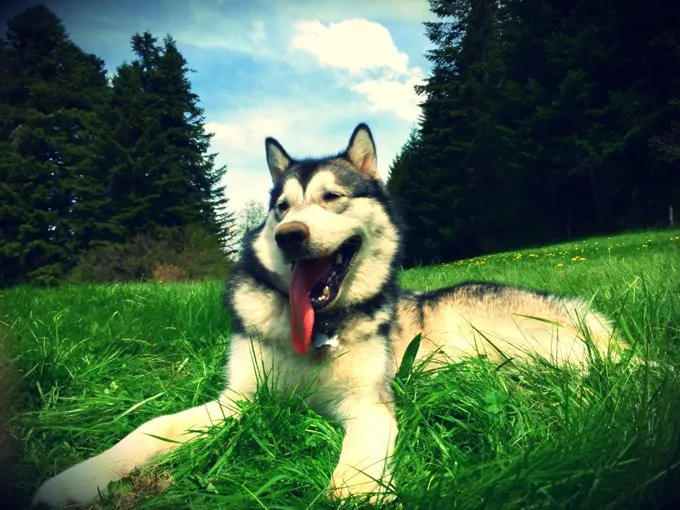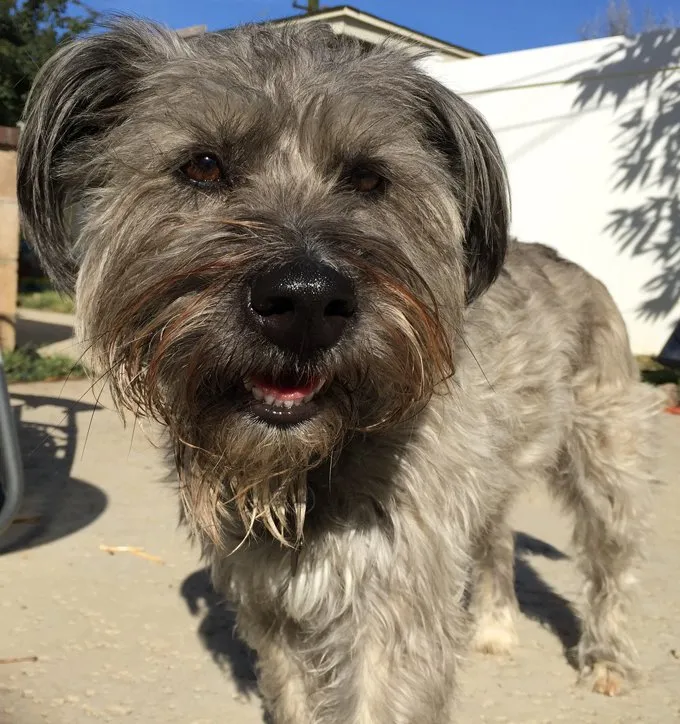
There’s an issue facing dogs that, while not very well known, can be fatal. And this issue, my fellow dog parents, is zinc deficiency. Zinc deficiency mostly affects Huskies and Malamutes, but it’s recognized as impacting other breeds too, most notably giant breeds (especially Great Danes and St. Bernards) and large breeds, such as German Shepherds and Dobermans. And unfortunately, even if your dog isn’t one of these breeds, zinc deficiency can still affect her. Given that the issue isn’t familiar to most people but impacts lots of dogs, I wanted to share some information about it with you, especially how to recognize it and what to do about it.
Before we dive in, I’d like to encourage you to do as much research as possible about this issue if you suspect your dog has a zinc deficiency. There’s some really good information available online, and you can also talk to a veterinarian or a certified animal naturopath (in either case, make sure you find someone who’s familiar with zinc deficiency in dogs). This is especially true when it comes to supplementing to help with zinc deficiency: you can harm your dog if you supplement inappropriately, and too much zinc can be fatal to dogs.
That being said, let’s look at how zinc, and conversely, a zinc deficiency, affect the health of your dog.

Zinc and dogs
Zinc is the second most commonly used mineral in your dog’s body. If it’s not present in adequate amounts, it can lead to a wide range of issues, and it can eventually result in death. Zinc deficiency seems to be more prevalent in Huskies and Malamutes; they seem to require a higher-than-average amount of zinc (compared to other breeds).
Malabsorption and mal-digestion
Some dogs can’t effectively use the nutrients that come into their body. There are a lot of reasons for this, but usually it’s because their body doesn’t properly absorb vitamins, minerals, and other nutrients present in the food (malabsorption) or their digestion is impaired (mal-digestion). Interestingly, both malabsorption and mal-digestion are often related to the dog’s diet.
Zinc deficiency: a multi-symptom problem
Frequently, when a dog is zinc deficient, she’ll present with a variety of symptoms. In many cases, the symptoms change over time, with different symptoms appearing as the deficiency continues. Because the symptoms often appear unrelated to each other, conventional treatment may try to address the symptoms individually. However, if the underlying issue (zinc deficiency) isn’t addressed, the symptoms will continue and get progressively worse. The good news? With the right approach, you can help ensure your dog doesn’t become zinc deficient (and you can help them overcome it if they do have a zinc deficiency). Since zinc deficiency is related to diet, providing the right diet goes a long way towards keeping your dog balanced and thriving. But more about that later.
I get that zinc is important. But what exactly does it do?
After iron, zinc is the most plentiful essential trace mineral in your dog’s body. It’s a powerful antioxidant and aids in various metabolic processes in the body. Zinc works by itself and with other nutrients, such as copper, B-complex vitamins, vitamin A, calcium, and phosphorous, to support the body and aid in different essential bodily functions.
Here’s the kicker: even though zinc is one of the most important trace minerals, the body has no way to store zinc. That means the body needs a regular, adequate supply of zinc; if it doesn’t get this, it will become deficient in zinc.
Studies have shown that only 15–40% of ingested zinc from the mammalian diet is well absorbed, and if a dog has malabsorption or mal-digestion issues, this percentage is even lower. Furthermore, certain foods can make it more difficult for your dog to absorb zinc properly, which only adds to the deficiency problem.

Common symptoms of zinc deficiency
Your dog’s body uses zinc for many processes. There’s an order in which these processes occur; if there isn’t enough zinc, not all the processes can be completed. Over time, if this happens consistently, your dog’s health will begin to suffer in various ways. In general, the signs of zinc deficiency present in the following order:
- Chronic digestive issues (owners sometimes assume these are food allergies). These often include diarrhea and a lack of appetite (the lack of appetite is sometimes attributed to being a “picky eater”).
- Crusty, raised patches of dermatitis. These most often occur around the eyes, on the muzzle, on the paws, or on the groin. Sometimes mistakenly diagnosed as hot spots or skin allergies.
- An under-functioning or overreactive immune system (in other words, the immune system is unable to handle infections, or it responds to everything as though it’s a threat). In general, during this stage, your dog may present with various seemingly unrelated illnesses, but in reality, they are all immune-system related. In this stage, cancers may develop.
- A malfunctioning thyroid gland, leading to weight gain or weight loss, increased or decreased appetite, skin and coat problems, and secondary infections. Your dog may also have a persistent cough. The body’s hormone levels are generally out of balance at this point.
- Major organ failures (including kidney failure, liver failure, and/or heart failure).
- Seizures. These occur because, if there is insufficient zinc, taurine in the brain can’t function effectively as a neurotransmitter smoother, and erratic neurotransmitter firings (in other words, seizures) can result.
It’s important to note here that while this is generally the symptomatic order zinc deficiency follows, some dogs don’t follow this list. They may skip a few symptoms, or they might skip the initial symptoms and jump right to the end (or close to the end) of the list. Being proactive in making sure your dog is getting and absorbing the right amount of zinc (instead of waiting until your dog is exhibiting symptoms) is the best policy when it comes to making sure your dog never has to deal with this.
Now that we’ve taken a quick look at the signs of zinc deficiency in dogs, let’s examine each one in some detail.
Chronic digestive issues
Chronic digestive issues are often the first indicators of zinc deficiencies. Many Huskies especially seem to have diarrhea and other digestive issues. Often, veterinarians recommend the owner change food. This generally doesn’t fix the issue, and the dog continues to have diarrhea. The bouts of diarrhea prevent the body from properly absorbing the zinc, and it becomes a snowball effect.
If a dog is experiencing chronic digestive issues because of zinc deficiency, it generally indicates either they aren’t getting enough zinc in their diet, or they aren’t absorbing it properly. The best sources of dietary zinc are whole raw meats and fish. Diets that don’t have an adequate amount of meat, or diets that have heavily processed meat, can lead to zinc deficiency. Additionally, diets that are high in corn, wheat, and/or soy (which is typical of many processed dog foods) can lead to malabsorption by making zinc unavailable to the body. This is because when these grains are broken down, they create phytates. Phytic acid bonds to zinc in the intestine and prevents the body from absorbing it properly.
The takeaway? Feeding a species-appropriate raw food diet that is balanced and varied will help keep your dog’s digestive system functioning properly and allow them to digest and absorb adequate amounts of zinc. And if your dog is showing symptoms of zinc deficiency, it will decrease the money you spend on vet bills trying to address the issues that will continue popping up.

Crusty lesions (Zinc Responsive Dermatosis)
If zinc isn’t available in sufficient amounts, it can disrupt normal cell division, which can cause the skin to become dry and flaky. Eventually, raised, crusty lesions begin to form. They can also form because of an under-functioning immune system.
These lesions are uncomfortable and itchy for your dog. They also tend to spread, and while they frequently respond to topical zinc creams, as soon as the cream is no longer applied, they generally come back, often worse than before.
Immune-system-related illnesses
T-cells assist in the proper functioning of the immune system (they help recognize foreign invading cells, including bacteria, viruses, and cancer cells). If there aren’t enough T-cells, or if the T-cells are compromised, the immune system can’t effectively differentiate between normal cells and invaders. That, in turn, can lead to the immune system either overreacting or under-reacting. And, to make matters worse, if you use antibiotics to clear up any lingering infections, it can cause more issues: antibiotics kill the intestinal bacteria, leading to more digestive issues (and since zinc deficiency is a digestion issue, you can see how causing more digestive issues is a really bad idea).
The body needs zinc to make T-cells. The good news is that when there’s enough zinc, many of these issues will disappear. That’s why it’s so important to educate yourself and make sure you are taking a proactive approach in making sure your dog’s nutritional needs are being met.
Thyroid and thyroid gland issues
The thyroid is responsible for producing hormones and regulating hormones that are responsible for metabolism and organ function. If your dog has a thyroid deficiency (or if your dog’s body begins to attack the thyroid glands because of immune-system issues), she may experience (among other things) hair loss, dry and/or flaky skin, weight issues, ongoing infections, problems with digestion, and even organ failure.
Remember I mentioned there’s a hierarchy of how the body uses zinc? The body directs zinc to the thyroid only after directing it to various other functions. And if there isn’t enough zinc, then the body may not direct any of it to the thyroid. If this happens on a regular basis, eventually the thyroid may not be able to produce adequate hormones.
Major organ failure
If zinc isn’t available in adequate, regular amounts, the body can’t support the major organs, which eventually fail.
Seizures
If there isn’t enough zinc, taurine uptake is hindered. And without adequate taurine, the brain’s neurotransmitters can become over-excited and begin firing randomly. When this happens, a seizure can result. Seizures related to zinc deficiency can range from Petite Mal to Grand Mal.
Zinc and diet
It’s true that every dog needs zinc in their diet. It’s also true that Huskies and Malamutes seem to need higher-than-average amounts of zinc. However, not every dog (or even every Malamute or Husky) needs huge amounts of zinc supplementation.
Even though they’ve been domesticated for thousands of years, dogs are still designed to eat species-appropriate raw food diets—raw meat, bone, organs, and glands. Dogs have dietary requirements like wild canids, especially wolves. So, before you start adding supplements, you should review your dog’s diets to see if any changes should be made.
When looking at your dog’s diet, be aware of the following things:
- Your dog’s diet shouldn’t include wheat, corn, or soy (or any other kind of grain).
- Your dog’s diet should be whole-meat based (rather than relying on meat by-products or meats that have been heavily processed). Eating raw meat can increase zinc levels naturally (and your dog’s body can absorb zinc from raw meat relatively easily).
- If you feed your dog a processed kibble, be aware that many dog food manufacturers add zinc to the food, but they add a cheap source of zinc in the form of zinc oxide or zinc sulphate. Your dog’s body cannot easily absorb or use these forms of zinc, and often, zinc deficiency will result. Again, a properly balanced and varied species-appropriate raw food diet is the best way to ensure that your dog is getting an adequate amount of zinc that he or she can absorb appropriately.
Foods that are naturally high in zinc (when fed in raw form)
- Beef
- Buffalo
- Chicken
- Egg
- Goat
- Halibut
- Lamb
- Ostrich
- Pork
- Rabbit
- Sardine
- Turkey
Fish oil is another good source of zinc. Keep in mind, however, that too much fish oil can deplete vitamin E in, supply too much vitamin A, and cause an imbalance between omega-3 and omega-6 fatty acid ratios. If you’re thinking about giving your dog fish oil, consider all the other sources of Essential Fatty Acids (EFAs) in her diet to make sure you don’t give too much.

Supplementing zinc
If you’re feeding an appropriate diet but your dog isn’t showing any improvement, you may have to supplement. One commercial supplement is Zinpro, which is an organic supplement of zinc methionine. Your dog’s body can absorb this type of zinc easily into their bloodstream.
There are other zinc mineral supplements available, but before you start supplementing this way, there are some things to keep in mind:
- The body doesn’t have a way to store zinc, so it must get it regularly in adequate amounts
- Research suggests dogs need a lot more zinc than humans do (up to 100 mgs daily, while humans generally need less than 15 mgs daily)
- In general, you can only tell your dog is zinc deficient if they develop one of the signs I discussed earlier
- Not all forms of zinc work equally well for dogs
- Zinc supplements work best when given four hours after your dog has eaten (giving it four hours after, instead of with the meal, reduces the chance that calcium will interfere with the body absorbing the zinc)
- Zinc interacts with copper, iron, calcium, and vitamin A, so supplementing incorrectly can cause imbalances in other nutrients that can lead to adverse reactions in your dog
Most usable to least usable forms of zinc:
- Zinc citrate, picolinate, and gluconate are highly absorbable and easily used by your dog’s body
- Chelated zinc is slightly less absorbable than zinc picolinate and zinc gluconate, but it generally doesn’t cause as much stomach upset as some other forms of zinc
- Zinc methionine is relatively bioavailable and well-digested by most dogs
- Zinc sulphate is hard on the stomach, so in general, it is recommended you crush it and add it in the food. However, this makes it less absorbable
- Zinc oxide is very difficult for your dog to absorb. However, it’s cheap, which makes it the zinc of choice for many dog food manufacturers when adding zinc to their dog food
Zinc toxicity
Zinc can cause problems when given in large amounts. Single doses of 225–450 mgs can cause a dog to vomit, and lethal doses of zinc start around 900 mgs. Zinc toxicity presents in dogs in a variety of ways: excessive panting, vomiting, lethargy, diarrhea, rapid breathing with an erratic or fast heartrate, and even jaundice. If your dog experiences zinc poisoning, emergency medical intervention is necessary.
Determining how much zinc to give
The general rule of thumb is 25 mgs of zinc per 50 pounds of your dog’s weight. If you don’t see an improvement in your dog after six weeks at this level, you may want to increase the daily dosage to 50 mgs. Always, if you aren’t sure, consult with an expert who is familiar with zinc deficiency in dogs.
Conclusion
Zinc deficiency, while dangerous, doesn’t have to be a long, drawn-out death sentence. Being proactive—feeding a balanced, varied raw diet—will go a long way towards making sure your dog never faces this issue. And by being aware of the signs, you can act to address it through supplementation if needed.
-By Kristin Clark, MA, CSAN
Editor-in-Chief, Raw Pet Digest
Founder, Raw Pets Thrive Movement









